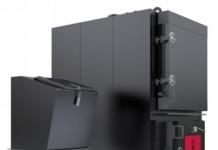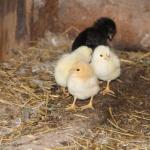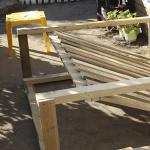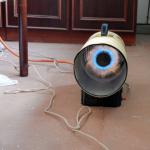Kira Stoletova
The floor in the chicken coop is one of the main components of comfort when breeding poultry. The well-being and egg production of chickens depends on how good the maintenance for birds is, whether the necessary minimum sanitary standards are observed in the construction of housing, whether there is wall insulation. A warm floor in a chicken coop is extremely important, and therefore many farmers are wondering how to insulate the floor with their own hands? After all, it is thanks to him that you can maintain the optimum temperature in the room, which will give decent egg production even in winter cold.

In winter, broilers, chickens and chickens should be kept in. If this is not possible, then it is recommended to allocate such premises as a warm garage, a polycarbonate greenhouse for keeping birds. Another option - before the onset of cold weather, you must choose the material and cover it with an earthen floor in the main room. All types of materials and their application can be studied in detail in a photo or video.
TECHNOLOGY of installation of HEATED FLOOR IN THE CHICKEN COOP for laying hens on the farm on their site
BOARDS ROTTED IN THE CHICKEN COOP FOR LAYING HENS - REPAIRS on the farm on their site
HOW TO MAKE A HEATED FLOOR IN A POULTRY HOUSE, A CHICKEN COOP FROM HAY AND CHIPS.
Device for chicken coops
The choice depends on climatic conditions and weather. When laying a cover in a poultry house, warm material is placed on the bottom - this is rule number 1, and it should not be broken. For example, a good option would be . It is changed as it gets dirty, but it is guaranteed to retain heat. If the winters in the region are very cold, you can’t do without heaters in the poultry house.
poultry house cover
How to insulate the floor in the chicken coop so that it protects birds from bad weather and rodents that are dangerous? If you properly equip the sexual space, then in the cold season in the house the birds will remain warm, and in the summer the optimum temperature will be kept, which will make the chickens comfortable. so that their paws do not freeze and there is no pneumonia, you need to make the floors a little soft.
Some farmers do not understand why special chicken coop floors are needed and simply opt for a regular chicken coop net, but this is wrong. The mistakes of negligent owners are recorded in many videos.
There are several types of flooring materials
- concrete;
- wood;
- Earth.
Each material has its pros and cons, so it’s quite difficult to determine which floor to make in a chicken coop is better: they are all different in terms of the time the floors were made from them, and in price if the home for birds is made by hand. In newfangled poultry houses, you can also make an electric floor. This is very convenient when it becomes necessary to turn on the heating so that the laying hen hatches the eggs and does not freeze. It is most difficult to clean the floor from wood or soil, which during construction is enough to simply pour on the floor.
earthen floor
Based on this, we can conclude that such a coating device will not fulfill the main tasks. Additional strengthening with clay can help in this situation. Due to its properties, it can provide fairly good moisture absorption. Such a flooring will be stronger and more durable, as the clay will be more and more compacted every day. For sufficient waterproofing in the house, a layer of clay should be at least 10 cm, and if there are a lot of chickens, then even more.
Concrete floor
Even a novice farmer is able to build concrete flooring with his own hands, since the manufacturing technology is quite simple. Such a floor gives complete protection against the penetration of predators, but does not keep heat, regardless of the season. You can cope with this feature if you simply lay an additional layer of natural material, due to which the chicken coop will cool down much more slowly.
Also, a special dense material, for example, a drainage mesh, will not be superfluous. Concrete floors in the chicken coop are characterized by good resistance to water and alkalis. Such a coating is non-flammable and can last up to 25 years, which none of the floors made of other material can boast of.
Wooden floor
If the material from which the flooring for the chicken coop will be made is determined, you need to read the manufacturing instructions and proceed with the construction. If you build the floor with your own hands, then material costs are noticeably reduced. If the chicken coop is supposed to be small, then an earthen floor can be used for it, if it is large, a wooden one. First of all, you need a foundation.
In this case, a columnar one is suitable for the house, thanks to which the flooring is at some distance from the ground, which increases the life of the floors. If the floor is concrete, the foundation is not required. Next, logs from the timber are placed on the cabinets so that they are parallel to each other. The space between the lags can be covered with heaters. Next lay the boards.
How to insulate the floor?
How to insulate the floor in the chicken coop correctly, based on various materials during construction? Wooden coverings retain heat on their own, but if frost is expected, this is not enough. You can warm the room with the help of bedding in the chicken coop on the floor. They will be able to maintain the room temperature up to 26°C even in cold winter. It is not recommended to insulate the floors in the poultry house with modern materials. Raw materials of natural origin, such as sawdust, peat or straw, are better suited. A thick layer of bedding is laid on the floor, a new one is added as it gets dirty.
Moss peat is the best option for warming the floor in a chicken coop, because such a litter does not allow the room to cool down and perfectly absorbs all the moisture, thereby eliminating unpleasant odors. Laying hens get good egg production on this type of litter. If it is decided to insulate the floors with sawdust, then shavings from coniferous wood are best suited for this, as it has a bactericidal effect, absorbs moisture and does not cake.
Anyone can insulate the floors in the chicken coop, for this you just need to decide on the material and make a little effort, then the maintenance of the birds will improve. It should be well understood in all the nuances of each material for the highest quality room for chickens. In good conditions, chickens are less exposed to various. Only after making a high-quality floor can you start breeding chicks. If the house is done correctly, the chickens will feel comfortable at any time of the year, which will allow them to carry more eggs.
Ultimately, underfloor heating in a chicken coop is what best contributes to the health and productivity of birds. Questions about whether a thoughtful floor is needed in the chicken coop should disappear by themselves.
It should be understood that when you and I decide to start our own household, we will need to put a lot of effort into this. And we are talking not only about the care and maintenance of their birds or animals, but also about the housing that they need. Most often, we have to build and equip it with our own hands. Although in order to do this, you will need to try and study all the information regarding this issue. And all for the comfort of the animals. Therefore, you will learn more about how to build the right floor in the chicken coop and which one is better.
When you decide to make a warm floor for a chicken coop with your own hands, you will need to pay special attention to the materials. Because they are different and which is better, it's up to you. Although each of them has its pros and cons. Basically there are concrete, earthen and wooden floors. And all of them will differ not only in their structure, but also in the cost and time that you will spend when you decide to make the floor in the chicken coop with your own hands.
And you will not forget about cleaning in such a room for a second, because due to waste and earth mixed with water, whole heaps of dirt will form. If you still decide to build such a floor with your own hands, then you will need to additionally strengthen it with clay. Such a floor is popular in many households because of its cost-effectiveness and minimal time costs.
If we talk about the advantages of such a coating, then it is better because it is not only resistant to water, but also to various acids that may be contained in detergents. It also does not burn and practically does not deteriorate. After all, if you build it correctly, it will serve you for at least 15 years. And what other option can boast such a plus?
Here, most experts consider wood flooring to be the best option of all those that you can do with your own hands. After all, it should be exactly that, which will simply keep the temperature perfectly and will always be warm. He is unlikely to need any bedding and in itself it is famous for its environmentally friendly cleanliness. Although due to its naturalness, it will require special care. After all, bugs can live in a tree and the material itself can deteriorate over time. In addition, wood is highly flammable.
Therefore, most use lime, which covers the floor in the chicken coop, this must be done in order to protect the birds from various bacteria and microorganisms. If you wish, you can even insulate or replace pieces of wood if you want the floor to look like that. Another trick can be considered the fact that it is better to make the coating at an angle in order to further simplify cleaning.
The wooden floor will always remain warm, and the bedding for it will not need to be made more than 7 cm. And then the chickens will be warm both in winter and in summer. And this is already a big plus. After that, you can make a chicken coop with your own hands the way it should be in your opinion.
We make ourselves
When you understand that the best floor is wood, the question arises of what it should ideally be and how to make it yourself. You will need to start with laying the foundation, and here you will also need to choose what it should be, because there are several options. You can lay both columnar and strip foundations. If you decide on a columnar option, you can be sure that the floor itself will last you longer, there will be a slight adjustment in temperature indicators and the wear of such a coating will not be so noticeable. And all because the columnar foundation creates an elevation.
The material for the foundation is most often concrete, but if you don’t have it, then it can be easily replaced with iron sheets. As for the strip foundation, it is not so common in the construction of outbuildings, because its task is to transfer the load from the supporting structures to the ground. For this, closed iron bars are erected in the form of a grid, which are then poured with concrete.
You must decide not only what the floors should be, but also what list of materials you may need in order to make such a building with your own hands.
Materials and tools
Therefore, you will need:
- wooden boards;
- bars;
- nails;
- cement;
- saw;
- hammer;
- bricks.
Step-by-step instruction
- First of all, you need to think about building a foundation, if there was none. To do this, you need to lay bricks with a cabinet with a height of about 25 cm. And you need to do this every 50 cm. If you previously had a concrete foundation, then you will no longer need this procedure. And this is already a plus.
- After that, you will need to put wooden logs on your brick pedestals, which you should have made earlier with your own hands or buy them. And remember that you need to lay them with a slope to simplify your life in the future.
- Your next step for building a floor with your own hands can be considered laying insulation between the lags, although this is not necessary.
- After that, lay the boards so that they are perpendicular to the joists. And before laying them, you need to make them so that they fall in the middle of the lag.
- Next, you should fix the boards with nails, and two jokes should be enough for one board.
- Do not forget that when creating a floor, wooden boards should fit snugly against each other and form a joint at an angle.
- Remember to cover the floor with lime or similar material to protect the birds and make the floor more resistant to wear and mechanical damage.
- Next, you will need to make floor insulation in the form of a deep bedding. After all, it is he who is the best because of his density and the right microclimate.
- Its material can be either straw and sawdust, or moss. Here you can also decide which one you will have. It is best if you mix it all with your own hands and make a combined bedding.
- After that, lay the bedding with a depth of 10-20 cm.
You can make such a floor with your own hands very easily and quickly, but you will need to take care of the litter. After all, if it was made from organic materials, then every season, or even every two months, it will need to be replaced with another. Also remember that a wooden floor will cost you a little more than an earthen one, but it will be warm and comfortable for the hens. Only if you have it, you will be sure that your birds will live a happy life, and you will get high-quality eggs and meat.
Video "How to start building a chicken coop floor"
In the video below, you can see where to start building and how to lay the foundation for building a wooden floor in a chicken coop.
Russian winters are so cold that even chickens stop laying between November and March. So that the chickens do not stop laying and in the winter, it is enough to equip a warm chicken coop ..
But as practice shows, this is not an easy question, and problems often arise when choosing heating methods. It is necessary to take into account many factors, conditions, calculate financial costs, and then make a decision on a specific heating method, choosing the best one.
The fact is that heating the chicken coop with a warm floor is the most convenient option, since external heating methods that were often used earlier - ceiling open IR heaters - do not cope with the task and consume a lot of energy. The peculiarities of this room are that there are always a lot of feathers and fluff: in addition to polluting the air, they can get into open-type heaters and cause a fire. But using underfloor heating in the chicken coop helps. eliminate all these shortcomings: feathers, fluff and other debris do not interact with the warm floor, in this regard, the risk of fire is excluded.
Types of Electric Chicken Coop Floors
Since indoor temperature is very important for chickens, the main task of heating is to make them feel comfortable in their house. The device of a warm floor in a chicken coop in a chicken coop has numerous advantages, which include:
- the bedding that covers the floor in the chicken coop is constantly heated, which avoids moisture;
- it is possible to set the exact temperature in the room;
- young animals are constantly in comfortable conditions without drafts and hypothermia;
- guarantee of electrical safety and moisture protection.
The heating of the chicken coop with a warm floor is carried out using an electric floor heating, which is offered in two types:
- cable;
- film.
TOP5 underfloor heating for a chicken coop
Cable underfloor heating for the chicken coop
The biggest disadvantage of cable underfloor heating is that a concrete screed is required for its installation. That is, such a warm floor resembles a multilayer cake:
- the first layer of concrete screed makes the floor perfectly flat;
- then a layer of insulation is laid;
- after - reinforced mesh (gives maximum rigidity);
- then - cable, cable mats for electric floor heating;
- screed layer (can be replaced with a layer of tile adhesive);
- finishing flooring.
Such a “sandwich” of a cable underfloor heating is somewhat irrational, since its arrangement takes a lot of time, a lot of effort is expended, and the height of the room can be significantly reduced by laying a concrete screed.
Optimal underfloor heating for a chicken coop
The most optimal warm floors in the chicken coop are film ones that do not need to be laid in a screed. To lay a film-type warm floor, it is enough to level the subfloor, which can be achieved by laying boards and a thicker layer of insulation, which will smooth out all existing surface irregularities.
In addition, heating the chicken coop with a film-type warm floor provides numerous advantages:
- positive effect on the body of the chicken due to the emitted infrared radiation;
- has high energy efficiency (saves electricity several times more than other types of electric floors);
- provides uniform heating of the room due to graphic spraying;
- has the ability to quickly warm up the room and maintain it for a long time;
- due to the use of a cloudy polymer in the manufacture, thermal deformation of the floor during operation is excluded;
- the risk of failure due to sparks is eliminated or reduced to a minimum.
The floor with the laid IR film consists of the following layers:
- draft floor;
- insulation;
- film warm floor;
- the flooring, which in chicken coops is most often made of wood, however, the flooring can also be made of any other material, sprinkled with sawdust as a result.
To regulate the temperature in the room, it is necessary to install a thermostat, with the help of which a comfortable temperature will be constantly maintained in the chicken coop. You can choose a thermostat suitable for the selected "warm floor" system in the chicken coop in the "" section.
If you do not know how to solve the issue of creating the optimal temperature in the chicken coop, please contact the managers of our company for a free consultation: highly qualified specialists are ready to solve even the most difficult tasks of installing any type of underfloor heating.
Turning to our managers, you can always get answers to all questions regarding the installation of underfloor heating in any, even the most non-standard room.
Heated chicken coop in winter- a tricky business. In sub-zero temperatures, the egg production of a bird is critically reduced, and the birds themselves get sick more often. How to avoid such troubles?
Chicken coop heating options
Previously, chickens were thrown into the attic in winter, settled in a warm barn, in the underground, or even in the house. Today, such measures are considered obsolete, the issues of winter maintenance and heating of the chicken coop can be solved in modern ways. Namely, to automate the bird care system. It should be noted that well-known radiators, convectors, heat guns and potbelly stoves are quite dangerous ways of heating, because the chicken coop is full of dust, droppings and fluff. Infrared lamps explode quite often. It is not advisable to install a heating boiler or a brick oven, a boiler room, a boiler room in such a room. How and with what else can you heat a chicken coop in winter?Underfloor heating, namely infrared film, is surely becoming a good help in farms. Its cost has become very affordable, and the assortment generosity allows you to choose the most suitable option for a variety of purposes. And the installation of the film in cages for hens, flocks and any premises where immature young and adult birds are kept is quite quick and easy. Because infrared heating and poultry farmers fell in love.
Floors on the ceiling
Infrared floor heating in a chicken coop is not quite a floor. The film is mounted on a wall or ceiling, therefore, it is possible to prevent contact of the heating system with the bird. It does not warm the air, but the walls, the floor, the perches and the chickens themselves. And objects are already giving off heat into the air by convection. Therefore, the heating of the room occurs evenly, without dust whirlwinds and oxygen combustion. The warm floor in the chicken coop is fireproof, it does not make noise, its operation does not require constant monitoring. And yet, infrared heating allows you to reduce the humidity of the air, thereby relieving the chicken coop from fungus and mold. Thus, the winter heating of the chicken coop with IR film allows you to achieve the microclimate necessary for the healthy life of birds.
How to calculate and mount
First you need to calculate the footage of the film. It is better to install it on the wall: mount the film so that the heat is directed to the nests and perches.We present the calculation of the film for an unheated wooden room.
Initial data 1:
The size of the chicken coop is 10 sq.m., 3 external load-bearing walls (100x100 timber insulated with mineral wool), wall height 2000 mm, window 500x500 mm, wooden frames, double, insulated door 600x1200 mm, earthen floor (from below waterproofed with roofing material). Region: Krasnoyarsk (winter temperatures -20 ... -35). The required indoor temperature in winter is -5 ... +5.
Calculation of a warm floor in a chicken coop for Krasnoyarsk
Based on the fact that the minimum temperatures in the Krasnoyarsk Territory can reach -42°C, the total heat loss of this room will be about 0.65 kW. We summarize the heat losses of the front door - 250 W and the windows - 100 W with the heat losses of the room, obtaining a total heat loss of 1000 W. To maintain the required temperature and compensate for heat losses, we calculate the heating power per cubic meter of the room:
The total volume of the room (hen house) is 10 sq.m x 2 m = 20 cubic meters.
Required power per cubic meter 650 W / 20 cubic meters = 32.5 W / cubic meters. Summing up the additional heat losses, we get 650 W + 250 W + 100 W = 1000 W - the total power of the required heating system.
A standard infrared film has a power of 0.22 kW/sq.m, hence for space heating 1000 W / 220 W / sq.m. will be required. = 4.55 sq. m of film.
Initial data 2:
The size of the chicken coop is 10 sq.m, 3 external load-bearing walls (100x50 timber insulated with mineral wool), wall height 2000 mm, window 500x500 mm, wooden frames, single, door 600x1200 mm, earthen floor (from below waterproofed with roofing material). Region: Moscow region (winter temperatures -8 ... -15). The required indoor temperature in winter is 0 ... +5.
Calculation of a warm floor in a chicken coop for Moscow
Based on the fact that the minimum temperatures in Moscow and the Moscow region can reach -30°C, and the room is not sufficiently insulated, its total heat loss will be about 0.55 kW. We summarize the heat losses of the front door - 175 W and the windows - 75 W with the heat losses of the room, obtaining a total heat loss of 800 W. To maintain the required temperature and compensate for heat losses, we calculate the heating power per cubic meter of the room:The total volume of the room (hen house) is 10 sq. m x 2m = 20 cubic meters
Required power per cubic meter 550 W / 20 cubic meters = 27.5 W / cubic meters. Summing up additional heat losses, we get 550 W + 175 W + 75 W = 800 W - the total power of the required heating.
A standard infrared film has a power of 0.22 kW/sq.m, hence for space heating 800 W / 220 W / sq.m. will be required. = 3.64 sq. m. film.
Installation
The distance from the heating surface to the perches should be about a meter. In addition to the film itself, you will need double-sided tape, a mounting kit, a thermostat, a reflective backing, and a couple of sheets of plywood. One sheet of plywood is needed in order to install a heating system in the chicken coop (the film is laid only on a flat surface), and the other is to prevent the bird from pecking at the infrared film. A reflective substrate is required so that heat does not escape through the walls to the street. A thermostat - to regulate the operation of the film and save energy. Thermal sensors record the temperature in the chicken coop, as well as the temperature of the heated film, and, depending on the set program, the warm floor in the chicken coop turns on and off on its own. Thus, smart electronics itself monitors the temperature in the room. Chickens for joy.The design itself looks like this:
We fix a sheet of plywood on the wall with self-tapping screws, to which we then attach a reflective substrate with double-sided tape. We fix the structure with planks. Then we prepare the infrared film for installation. To do this, we fix the clamps for the supply of electricity on the current-carrying busbars of the film, crimp the clamps with the supply wires of the power cable and isolate them at the place of fastening with a bitumen gasket. Then, with the same bituminous gasket, we attach thermal sensors to the surface of the film, and isolate them. Thermal sensors should not be superimposed on the radiating element, it is attached between the emitter strips on the film surface. At the next stage, we attach the infrared film ready for use to the wall of the chicken coop. First, we cut out a window in the reflective film - in the place where the fragment of the film with the temperature sensor will be located. We attach the film to the substrate with double-sided tape, with the tire up. We fix the wires on the substrate with ordinary adhesive tape, sheathe the entire structure with a sheet of plywood on top (to prevent the bird from pecking at the film) and fix the plywood with self-tapping screws. When installing an infrared heated floor in a chicken coop, it is necessary to ensure that screws do not get into the contact busbars and radiating elements. To do this, we outline the contour of the fasteners with self-tapping screws on plywood. We place the thermostat in an area inaccessible to birds and close the appropriate signal and power cables with corrugated pipes. That's all, chicken coop ready for winter.
Which film to choose
The field of application of infrared film is expanding every year, new generations of it are being produced, suitable for the most unexpected solutions. Almost any film can be mounted on walls and ceilings. Vertically, horizontally, locally. It remains to choose a manufacturer you trust. And take into account some features: for example, if you have a very humid room, choose a film with a moisture-proof coating. Practice shows that for an ideal result it is not necessary to buy the most expensive and "promoted" infrared film. In our case, we can be content with the cheapest South Korean film (Lavita LH, RexVa Xica, Q-Term), it fully justifies itself in work.
Material selection
The choice of means for warming depends on the climatic conditions of the region of residence, but an indispensable condition is the creation of a temperature regime that is kept at the level of 10-15 ° C. Among the frequently used natural ingredients that allow you to make a warm floor in a chicken coop with your own hands, includes dry grass and wood shavings, which, when arranging a chicken coop, act as an additional method of warming.
Properly selected and equipped underfloor heating for the chicken coop is the key to the health of poultry. In winter, it retains heat, protecting chickens from colds and pneumonia. In summer, it maintains the optimum temperature, providing comfort to the layers.
It is possible to insulate the floor in a chicken coop using concrete, wood or soil, and electric heating is also a good option.
ground cover
The most economical and simple option is the arrangement of an earthen cover, which is compacted soil or gravel. However, it has several disadvantages:
Clay coating when arranging an earthen floor in a chicken coop gives it durability and practicality, its layer should be from 10 cm or more.
concrete pavement
Concrete floor provides reliable protection against predators and rodents, is resistant to moisture and chemicals, its service life is up to 25 years, it is easy to clean, but it retains heat poorly. Eliminate this drawback with the help of additional bedding made of natural material and drainage mesh.
wooden flooring
Warm wood flooring is suitable for keeping adult broilers and chickens, because. natural material retains heat well and practically does not need additional insulation. Mesh cages are installed on the boards or mesh perches are equipped. The minimum thickness of the boards that are laid so that the flooring does not freeze through is 20 mm.
Important conditions for the equipment of a wooden floor are sanded boards and the absence of protruding nails.
Among the disadvantages are flammability and susceptibility to fungi and pests that destroy the wood structure. To maintain it, processing is required, often lime is used for this. To simplify the cleaning of a wooden floor allows the arrangement of the flooring at an angle.
To prevent rotting processes, the wooden floor for the chicken coop is treated with water-repellent agents.
Floor Equipment Technology
Do-it-yourself floor insulation in a chicken coop usually begins with pouring the foundation, which many people prefer to be columnar, it raises the flooring above the soil surface. Such a foundation increases the life of the flooring. The foundation is not necessary when it is made of concrete, as well as when arranging a ground cover in structures built on beams.
For a small chicken coop, soil flooring is suitable, for a larger one, made of wood. Plastic decks and nets emit toxic phenols and mold, so PVC is not suitable for decking.
The foundation pillars should be laid with lags so that they lie parallel, the space between them is filled with insulation. The optimal distance between the lags is no more than 0.6 m, which avoids deflection of the beams. To prevent heat from leaving, use a heat-insulating layer. Planks are laid on top.


















